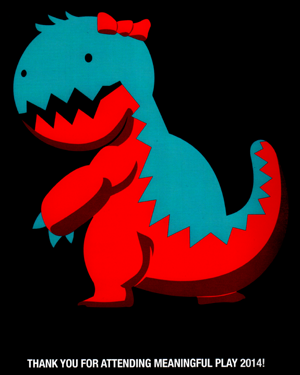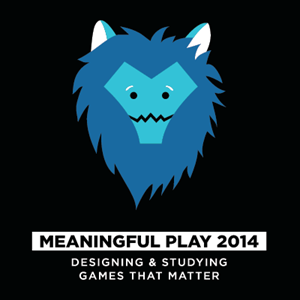Saturday was the final day of the best conference on meaningful gameplay.
This shorter day ends the Meaningful Play 2018 conference. As always, I leave with inspiration and a greater sense of purpose, not to mention hope.
Good morning! Thus begins the final day of Meaningful Play 2018. #mplay pic.twitter.com/h2fWhI9Jev
— Gregg Seelhoff (@GreggSeelhoff) October 13, 2018
Saturday morning keynote
Saturday morning keynote, The Promise of Games for Personalized Learning, by Diana Hughes @DiHughes of @AgeofLearning. #mplay #education pic.twitter.com/IOVmCdEjPl
— Gregg Seelhoff (@GreggSeelhoff) October 13, 2018
The day began with a very informative and practical talk, The Promise of Games for Personlized Learning, in which Diana Hughes of Age of Learning discussed and demonstrated practices they used in ABCmouse Mastering Math to teach and assess mathematics skills in children ages 4-8.
One fundamental takeaway from the keynote was the importance of providing proper understanding (mastery) of basic mathematical principles (of which I had not realized there were so many) before attempting to teach a skill that relies on those principles. The software uses various (positive) “scaffolding” for supporting a learner who does not demonstrate knowledge of a topic, as measured by incorrect answers in a game.
Initial results of scientific testing show great promise, based on significant improvements with just limited classroom time spent using the game, as well as anecdotal evidence from teachers that the software is effective. I believe that numerical understanding is as important as the ability to read for educational success, so these are hopeful results.
Breakout sessions
There were only two breakout sessions on this final day. For the first one, I attended Game Post-Mortem Microtalks II.
Postmortem microtalk by Pericles Gomes on the development of a simulation of a chicken farm in VR. #mplay pic.twitter.com/STsjwG5yD4
— Gregg Seelhoff (@GreggSeelhoff) October 13, 2018
The first (of 3) games featured was a VR simulation of a Brazilian chicken farm. Pericles Gomes presented the software running on Google Cardboard, along with some detailed information about the huge quantity of meat produced and exported from Brazil, and more detailed information about the number of chickens produced from the particular farm that was captured with 360 degree cameras to make the simulation. Even running in just Cardboard, the VR version had proven more effective than the tablet version.
Postmortem microtalk by Phillip Cameron of University of Michigan on development and results of games for supporting German language education. #mplay pic.twitter.com/CCQ9fedJRw
— Gregg Seelhoff (@GreggSeelhoff) October 13, 2018
The second postmortem was from Phillip Cameron about the use of games with students learning the German language. He presented the results of a limited survey of potential students and how likely they would be to continue with advanced German studies, and then again with similar classes using games and software. The total numbers showed a slight improvement, but upon correlating answers between the two questions, it was shown that some “likely” to continue initially actually became “unlikely” in the class with games, while other moved from “unlikely” or “unsure” to “likely”.
Postmortem microtalk by Mars Ashton @nujakujata on the development of Axis Descending (in Flash) and its ultimate cancellation. #mplay pic.twitter.com/Jh4R8FgPlU
— Gregg Seelhoff (@GreggSeelhoff) October 13, 2018
The third and final postmortem was by Mars Ashton, who is very active in the Michigan game development community, on his award-winning game project, Axis Descending. He discussed the personal origin of the project about a decade ago, its creation in Flash, the marketing and reception (including awards) of the project during development, and the ultimate decision to cancel the project. Mars was very upfront about how his focus on the game had become “unhealthy” and how that affected him and those around him.
We’re off to see the Rovi, the wonderful MSU Libraries Rovi Game Collection. #mplay
— Gregg Seelhoff (@GreggSeelhoff) October 13, 2018
For the second breakout session, I chose to do the Tour of MSU Libraries Rovi Game Collection. We walked to the MSU Library and, first, visited the Video Game Lab which houses the Rovi Game Collection, a collection of approximately 18,000 PC and console games dating back to the early 1990s (including at least 7 games I worked on 😉 ).
We then walked downstairs to visit the Digital Scholarship Lab, which is an impressive collection of technology available to students, faculty, researchers, and the public at large. It includes a 360-degree visualization room, with seamless video projected on the walls of the round room, a VR room with Oculus Rift and HTC Vive set up and ready for use, a room with scanners, including a small 3D scanner, and numerous very powerful desktop computers with just about all the creation and development software one could want.
On the way out, we also passed the MakeCentral Makerspace, which has 3D printing, structure scanning, laser cutting, and vinyl cutting available, as well as a technology lending program with a number of digital toys… I mean, tools. Very cool.
Saturday afternoon keynote
Final keynote of Meaningful Play 2018, Imagineers at Play, by Bei Yang @beiyangles of (where else?) Walt Disney Imagineering. #mplay pic.twitter.com/7bhACsq8Vd
— Gregg Seelhoff (@GreggSeelhoff) October 13, 2018
The closing keynote was Imagineers at Play, by Bei Yang of Walt Disney Imagineering. He discussed several aspects of “imagineering”, including the many disciplines involved, how they test and revise experiences, and the benefits of using BIM (Building Information Modeling) for design of spaces. He then showed a number of projects, ranging from experimentation to final implementation, to illustrate the ideas. This included the revelation that an upcoming Disney experience will allow guests to pilot the Millennium Falcon!
The key takeaways were that the design loop (ideate, prototype, test) is essentially the scientific method (hypothesis, experiment, conclusion) in practice, and the following observations on technology:
- Everything is design
- Technology is making design loops faster
- Technology is changing what we can do in those designs
Coincidentally, I ended up asking the last public question of the conference, which was (from memory): For new experiences, does the storytelling drive the technology, or does the technology drive the storytelling? The short answer was, “Both.” The longer answer was that sometimes there is a story to tell and they seek out the best technology to do that, which sometime results in ideas being shelved, and other times advances in technology make it possible to tell a story that had been ruled out in the past.
Conclusion
Alas, now is the closing for Meaningful Play 2018, and I leave inspired once again. #mplay #seriousgames pic.twitter.com/hB3j7vfhlk
— Gregg Seelhoff (@GreggSeelhoff) October 13, 2018
I leave this awesome conference full of new ideas, as well as with a couple new goals to be completed before Meaningful Play 2020.



 Meaningful Play 2014
Meaningful Play 2014
